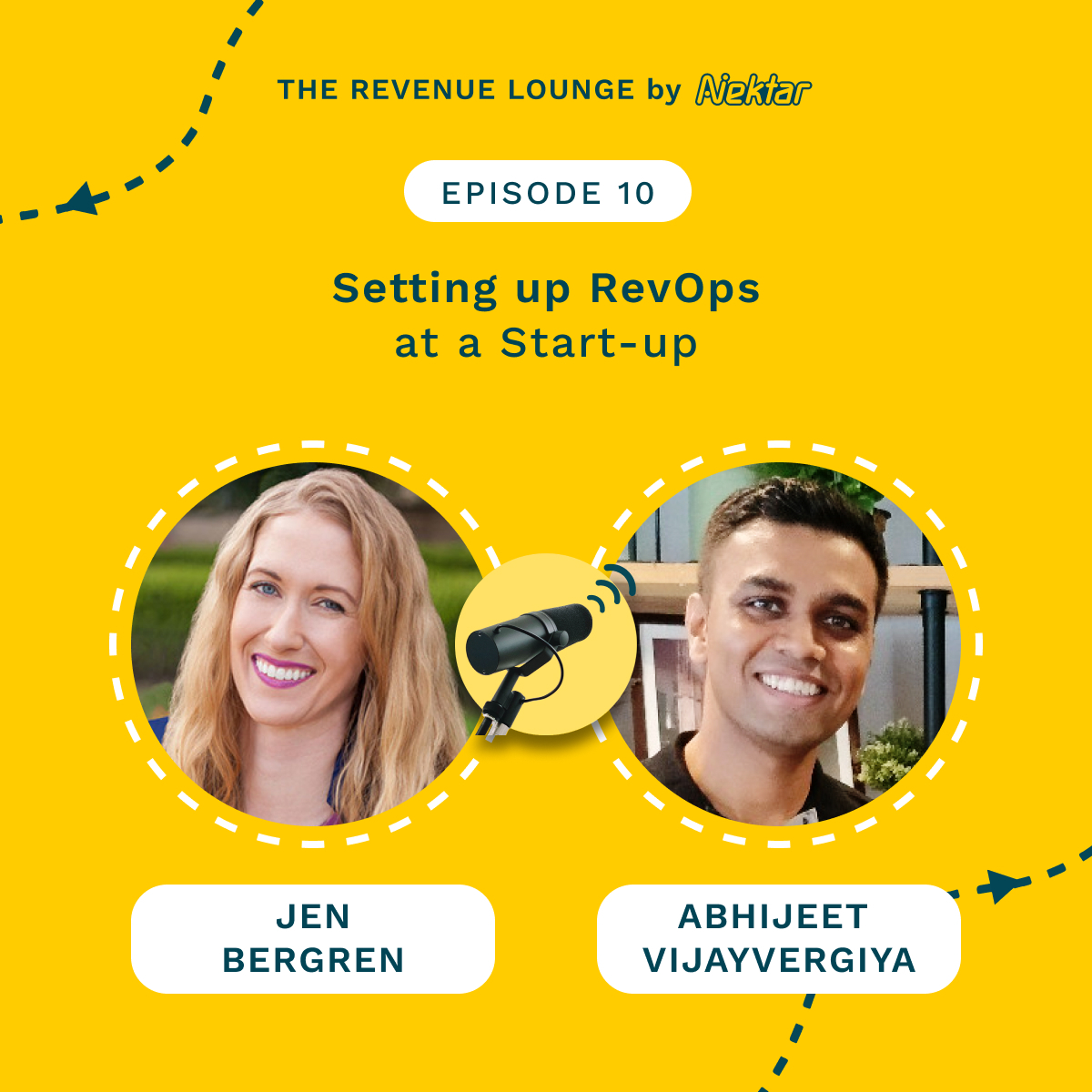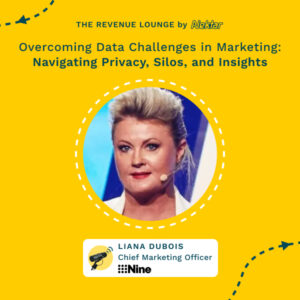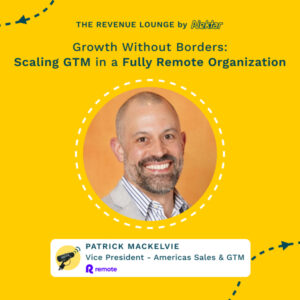Decoding the Buying Groups Model: Strategies for Success ft. Evan Liang
August 7, 2024

About
The Revenue Lounge
The podcast covers stories from leaders across RevOps, Sales, Customer Success, GTM, Data and Marketing about what drives these functions and what advice they would share with our listeners. With 3 seasons recorded, the podcast currently features 50+ enterprise leaders in the B2B SaaS domain. Tune in to hear from the best in the business
In this episode of the Revenue Lounge, host Randy Likas interviews Evan Liang, founder and CEO of LeanData. They have an in-depth discussion around buying groups – why they are becoming more popular, how companies are implementing buying group strategies, challenges with transitioning to a buying group model, and operational considerations. Listeners can expect to learn the benefits of buying groups, tips for getting executive buy-in, and key steps for starting a buying group pilot program.
Guest Bios:
Evan Liang:
Evan is the founder and CEO of LeanData, a company he started 12 years ago to make sales and marketing teams more efficient through better data and processes. He was previously a venture capitalist and product manager.
LeanData:
LeanData provides a revenue orchestration platform to manage buying groups and account-based marketing. They have over 1000 customers and help route leads, contacts, accounts, and opportunities to the right teams.
Key Discussion Points:
– Why buying groups are gaining popularity
– How to build a business case and get executive buy-in
– Best practices for starting a buying group pilot program
– Role changes required in sales development
– Importance of having the right data and technology stack
– Ongoing marketing involvement for mid-funnel buying group opportunities
Key Quotes:
“I think it’s about time. So that’s just on the the the macroeconomic scale.” (00:05:51)
“People always buying this kind of way. There’s always been enterprise buying groups.” (00:06:51)
“The movement is real. So the first part is get to know a lot of other folks at similar companies.” (00:28:21)

Randy Likas (00:01.326)
Hello, everyone. Welcome to the Revenue Lounge. I am your host, Randy Likas. And joining me today is Evan Liang, who is the founder and CEO of LeanData. Evan started LeanData 12 years ago, has built an incredible company serving over 1 ,000 customers. And the topic of today is going to be around buying groups. And what we’re going to do is break down this idea a little bit more into how do organizations think about it and how do they operationalize it within their company
Randy Likas (00:29.048)
Personally, it’s a big interest and passion of mine. It’s a very hot topic in the market. Something that’s really on a lot of the conversations that I’m having with my clients and prospects today. So Evan, welcome to the Revenue Lounge. Thanks so much for joining us today.
Evan Liang (00:42.125)
Glad to be here, really excited.
Randy Likas (00:44.014)
Right. So Evan, I usually like to start these out just learning a little bit more about you. So maybe talk a little bit about your background prior to founding Lean Data. And then 12 years ago when you decide decide to found a company, what were some of the problems that you were hoping to solve when you started the company?
Evan Liang (01:01.12)
Absolutely. So I’m a first time founder, but prior to Lean Data, I had been around the startup ecosystem kind of in two areas. One, I had been a venture capitalist, so I had been funding startups.
And so I’d gotten to know a lot of companies in and around that process. And the other was around product management. So I’d worked as a product manager at some bigger companies and also some startup companies prior to founding Lean Data. so always, actually it was always my dream to be doing what I do today. So really excited that I’ve been able to live that for the past couple of years. But at the same time, I think the initial genesis around Lean Data was around personal pain points around sales and marketing efficiency.
So I had Salesforce and I had an inside sales team at my last company. We were bringing on marketing automation and we had Marketo and as we were trying to make those two systems working, we got into a lot of data and process challenges, which made my sales and marketing team less efficient. So the initial genesis for Lean Data is around making sales and marketing teams more efficient using data and processes. So very much we’re doing exactly what we set out to do.
how we deliver that and that’s what we’re gonna be talking about things like buying groups. It’s certainly, certainly changed a lot over the years.
Randy Likas (02:11.306)
Absolutely. What’s interesting is I think when people are not familiar with you, they hear Lean Data, they go, hey, isn’t that the company that routes leads? And in reality, Lean Data is so much more than that. You guys could basically route to any object, to any field, integrate, send things to other systems. so there’s so much more that Lean Data does other than I think what people think about as leads. Anything more that you want to comment or talk about what Lean Data does?
Evan Liang (02:40.385)
Yeah, absolutely. So I think it’s a little bit to our history and also like the mission statement what we started. Ultimately, we’re trying to make your sales and marketing teams more efficient through data processes. So routing leads is a part of that, but not the whole totality of that. And so we were a pioneer in the category. mean, before us, no one really thought of like managing leads. The routing process is kind of very, very backwards.
And certainly throughout our history, we’ve kind of been very customer driven and involving with our customers and their go to market motions. And so that’s a big part of what we’re talking about is go to market motions have evolved and gotten more complex. And so our product and our company has evolved with folks. And so that’s where, like, as you mentioned,
Initially people just wanted lead routing and today we route across all the different objects and we really call it revenue orchestration because we’re really trying to orchestrate your data and processes in order for you to be able to deliver on go -to -market innovations like ABM or like buying groups to kind of hit your revenue goals and that’s kind of where we see our ourselves as the company. It’s not people we did start with lead routing at one point time but very much evolved beyond
Randy Likas (03:50.574)
Absolutely. Okay, great. So let’s frame our discussion today around buying groups. And I want to do that by maybe talking a little bit about sort of the history, in terms of why it’s so popular. So MQLs were, you know, started or invented, I guess it was probably 20 or 25 years ago, right? And it’s been the primary metric that marketing organizations are using to help measure the demand that they’re creating and that they’re passing leads off over to sales. And so…
you know, that’s really been sort of, everybody kind of looks at like how is marketing doing? They look at like how many MQLs that we’re generating, not all of that, but that’s a key component of that. So then like 10, 15 years ago is when, you know, account based marketing was introduced and you know, many, many organizations now have adopted that motion. And, you know, that’s even evolving more as well. And so, you know, then go back to like, I think it was 2017 or 2018, serious decisions now part of Forester.
started talking about how MQLs is really just not getting us to where we need to be. And they started introducing this idea of buying groups. so that’s really, they’ve been evangelizing the idea. It’s getting more and more attention. You and I were both at summit earlier this year, and the crowds for those sessions were just incredible. And so I think
part of what they’re talking about is just the nature of how the buying process has changed, right? Like people are not just going to your site and filling out forms and raising their hand, right? They’re researching your products and services. They’re back -channeling, having back -channel conversations. And so a lot of times there’s many more people who are involved in decisions than just the people who maybe were their hand raisers, right? And we’ve seen this all in our own data, right? We take a look at our own sales processes.
Evan Liang (05:38.122)
Yep.
Randy Likas (05:39.81)
and our buying committees are getting longer, deals are taking longer, it’s harder to get alignment and consensus, so on and so forth. So we’d love to hear a little bit more about sort of your point of view and sort of this journey, right? How has the buying process actually changed? And so what do you think are some of the drivers for why buying groups is being such a hot
Evan Liang (05:43.562)
Yeah.
Evan Liang (05:53.238)
Yeah.
Evan Liang (06:03.65)
Yeah, so I think there’s some bigger macro changes. Some things have changed, other things are the same, but it kind of still drives the evolution. I mean, I think the first thing is just what you outlined, Randy. It’s like every 10 years, you know, the analysts come up with kind of a new framework for how we want to do it. It kind of builds upon the other stuff. I think, like you said, MQLs is about 20, 25 years ago. They came up with the notion of MQLs. ABM was about a decade ago. And then I think this is why it’s the next evolution.
Kind of about time. So that’s just on the macroeconomic scale. And by the way, we were at the very beginning of ABM. So I kind of saw that waves. And I see a lot of similarities to that inflection point with what I’m seeing about buying groups, which is what’s exciting for me, having seen that previous wave and kind of have benefited as a company from that. I think there are certain things over that time frame that
digital has certainly come along. So a lot of the buyer’s journey is much more online. It’s not about just interacting with your sales rep. Most of the journey today
Far happening right beforehand and we’re able to capture those digital channels so that those digital buying signals, right? We’re really available like 20 25 years ago We have a lot of that so we can see that buying committee and everyone that’s involved with it And I certainly think in today’s macroeconomic environment people are being more diligent about their buying cycles Like you mentioned things are longer right there more people involved and that is also a short -term driver to it But then I would say also take a step
People always buying this kind of way. There’s always been enterprise buying groups. And so in some respects, when we talk to sales about buying groups, they’re like, duh, I’ve always been doing that. And in some sense, you’re right. Yes, you have. And so that’s why this is kind of taking on is because it is natural and it’s just about the rest of the org, the data and processes and technology catching up to how people have always done things.
Randy Likas (07:44.174)
Right? Right?
Evan Liang (08:01.11)
So in some respects, it’s not a new change, it’s just the next evolution, partly because the previous wave didn’t completely message it, but then also there are new trends like digital and short -term understanding that ABM and MQL didn’t deliver it, didn’t completely complete the picture because they weren’t really there to do it. The last thing I’d like to say about the fact that why buying groups makes sense is this was actually how the CRM was always developed.
It was always around having opportunities, the opportunity to contact Role. People just didn’t use it, partly because it was too hard and the technology and the signals weren’t there.
Randy Likas (08:33.112)
Yeah.
Randy Likas (08:37.132)
Yeah. So, you know, one of the things that really stood out to me is when I was at Summit earlier this year, there was a lot of case studies around companies who are starting to lean into this and seeing incredible results, right? So Siemens, Palo Alto, RelTO, when they talk about the impact that it’s making as far as faster conversions and better win rates, it’s really incredible. Yet, you know, when I have conversations, there’s people who are interested, but they
Evan Liang (08:49.951)
Yeah.
Randy Likas (09:05.752)
quite made the change yet. And so I’m curious, like from your perspective, like why haven’t more organizations, you know, moved to this motion yet? What are some of the common challenges that companies face when, you know, transitioning from sort of an MQL model, which we’re all used to and all of our, you know, our metrics are built around to this new way of doing things.
Evan Liang (09:27.285)
Yes, I think it’s the classic changes hard, right? I always I used to always show the graph and the way that if you if you there’s a discrete comic that’s like who wants change everyone raises their hand right and then you’re like who wants to change no one does does that make sense so I think that’s I think that’s just it’s your classic change management culture technology
Randy Likas (09:42.136)
Yeah.
Evan Liang (09:48.119)
bit data on processes. Like I’d mentioned, this is when we started Lean Data. It was about the fact that you have to change your data on processes in order to make your sales and marketing teams more efficient. But it’s hard. If it was really easy, you don’t need to buy technology or other things around that. And so that’s kind of the biggest thing is it makes sense. People get it. That’s part of the enthusiasm. But you’ve got to do all the things around people processing technology.
You’ve got to do all those three legs in order to make it happen. And I’m very confident everyone can get there. It’s just different organizations are ready to adopt and move at different speeds, which is why we do need to pound the table around the case studies. And those early adopters are paving the way for everyone else to follow. And once someone gets there first, it’s easier for the next person and the next person and the next person.
Randy Likas (10:44.738)
Yeah. So, you know, some of those companies that we mentioned, by the way, they’re all lean data clients. They are seeing, you know, incredible changes to their conversion and their win rates. But they all seem to be starting sort of smaller, right? They pilot, if you will, maybe with a region or a team or a product. And we’d love to your perspective in terms of what you’re seeing as well. You know, like if a company is thinking about doing this, how are they going about maybe those initial projects that kind of dip in the toe in?
Evan Liang (11:16.203)
Yeah, absolutely. like we said, one of the challenges is around cultural and getting buy -in from the executives. And anytime you’re talking about like data and processes, you’re talking about a lot of change. You’re impacting your entire go -to -market team.
And so we generally do see folks and recommend folks that you start with a small region pilot, show success, show that early win, right, to build upon it. And so I think the two key things that to get people started is one, you do need executive buy -in. So hey, you’ve got to build that business case and make sure that there’s alignment. I think if you go off and go rogue on this, that’s usually not a great recipe for success, right? So you want to get that initial executive buy -in. And then one way to do that is,
start small, get that pilot, get those early wins, which we’re definitely seeing, and we’re seeing some incredible numbers. The Forrester guys are talking about huge multiple increases in win weight and conversion rate and actually drivers to revenue. And that makes it easy to roll out to the next group, to the next group, to the next group. So I think that is a good best practice. The other thing I would say is, like I mentioned earlier, there are new communities of folks and people who’ve had success.
And the folks who are having that, they’re so eager to share. I love talking to our customers who’ve had success here and they’re so eager to be like, hey, we’ve gone there. But they’re also all realizing that no one’s at the finish line. So it’s not like, hey, look at me, I’m so great. They’re more like, hey, I can learn from you, you can learn from me. And so as everyone innovates on different part of it, it makes it easier for everyone else to get there. excited about the community of folks. And similarly, in the ABM days, there was early adopters who kind of got together.
Randy Likas (12:29.101)
Mm -hmm.
Evan Liang (12:58.869)
And they kind of drove it one difference from ABM I would highlight around this is ABM was primarily driven by Tech adopters and early stage venture -backed companies. We are seeing buying groups mostly being driven by larger enterprise companies So it is a different set of early adopters out there, which is exciting See if part of the reason for that is the pain points for enterprises around having multiple buying communities is higher and in many cases
Randy Likas (13:25.228)
Yeah.
Evan Liang (13:27.634)
ABM did not meet all their needs because like we have example that you said Siemens Siemens is sold to everyone they’re not interested in target accounts and how to break into account it’s about how you upsell cross -sell and get more of your product and market share and so that’s about buying committees it’s not about target accounts
Randy Likas (13:47.062)
Yep. So let’s drill into that a little bit more. So and specifically around when an organization is thinking about piloting something, how do they determine where to start? Do they look for like those, you know, those accountants that have very complex, you know, sales and multiple stakeholders? Do they look for like accounts where they haven’t been able to break in yet? Or do they look for accounts where they have broken in, but there’s so much expansion opportunity with different buyers.
then who may be who what made the initial sale so like when you what you’ve been seeing is when people are certain scope these things like what’s where they look
Evan Liang (14:26.089)
Yeah, I mean, I the first part that they generally want to look for is you do want more of a complex buying process. So I’d say like if you’re looking at like by segment SMB versus enterprise, that’s where I’ve seen most of the pilots are starting in the enterprise segment. In fact, like an SMB, like if you’re starting commercial transactional accounts, that’s probably not the right place to start, right? Because in that case, a buying group of one, like an MQL is a buying group of one, and that might be enough. So you
multiple people, the more complex sales cycles, that’s helpful. So I’d say that would be one line I would differentiate around. Other than that, around which products and stuff like that, I think that one becomes more cultural. Which group within your organization’s a little bit willing to act faster and being able to adopt and willing to try something new.
I’ve seen some people start overseas, right? I’ve seen other people start with more channel partners. I’ve seen other folks start with, you know, an upsell product. So I think in that case, I think that’s organizational specific versus SIPP. But I would definitely say complex buying cycle, larger ASPs, more people involved. That’s kind of the conditions you want to at least start with.
Randy Likas (15:40.302)
And when someone sort of introduces this idea in the organization, and it goes back to what we talked about with culture and change, Like, what are some of the obstacles that maybe people start hearing? Like, sales might say, don’t touch my opportunities, right? I own the opportunities, and you’re talking about something that’s sort of come over here. Like, what are some of the challenges that you’ve seen in maybe the change agents within an organization?
They’re trying to start this motion internally that they typically will run up against.
Evan Liang (16:13.473)
Yeah, so the first one is just an education. I think like I said, sometimes you go to sales and these initiatives today from what we’ve seen are often driven by marketing ops and marketing. Those are the primary people who are really glomming onto buying groups. Oftentimes you go to sales and sales is like, I just don’t get it. This is what we’ve always been doing. Isn’t this how our systems work? So there’s that part of it is just the inertia and getting the people to understand why this is slightly different. Once you get past that, you’re right then because this touches a lot of data and processes,
That is where you do get things like people run into obstacles like hey the opportunities you can’t create opportunities That’s the domain of sales right and but that’s where you know I think folks Working with their vendors and working with technology providers can help solve that so I would say you know I would say that’s where like you mentioned a lot of the early folks moving to buy -in groups
were Lean Data customers. It’s not because we necessarily targeted those folks. It’s because Lean Data provides a very flexible platform to allow you to differentiate and orchestrate all your different objects. And that just makes it easier to be able to manipulate and move towards buying groups.
So a lot of our early customers moved to buying groups without telling us actually. We found out later, we’re like, that’s interesting. But then they are missing things like how do I solve the zero dollar opportunities? And we are working with a group of our customers to kind of beta test and solve some of the problems. Another problem I’d say some people is data.
They don’t have enough of the data inside their system. So they may, the sales reps will not be entering their data into something like Salesforce. So that’s where we’re really interested in working with someone like Nectar, yourselves. You guys provide a of a great solution where you guys can capture that data that’s sitting in these other endemic systems like email and calendar and bring that in because that makes it more richer. So again, there are all these problems, but actually the funny part is they’re all overcomerable.
Evan Liang (18:15.266)
you can overcome them and actually what’s interesting is that technology has actually in the last 20 years matured to make this possible. Like I said, the concept of buying groups has been around forever but what has changed is the technology. Things like Lean Data and Nectar are making it easier for you to actually automate these steps in order to make that happen. So I don’t think technology is the hurdle
What I do think is the people and the process. So those are the parts that we want to focus on and work with around getting people moving because I think we can handle the tech or maybe even if there are things that could be automated a little bit, those aren’t the hard parts as I talked to many of the enterprise companies.
Randy Likas (18:58.52)
So, know, companies, if everything’s working great, like probably in systems weren’t broken or buying processes weren’t changing, like they probably wouldn’t go, you know, move to this motion. There, there’s some kind of a business problem that they’re typically trying to solve, which is why they’re, they’re, they’re, they want to do this. Right. So is it like, is it typically, you know, if I’m, if I’m a, a, marketer, you know, marketing operations, and I just know that like, I’m trying my best to, deliver the demands that the, the, the, the, to the sales team.
but we’re running short. We’re just not getting the high quality leads or we’re missing targets. What are the typical business challenges that an organization may be facing, which is why they’re even entertaining this idea to begin
Evan Liang (19:42.09)
Yeah, I mean, think it’s the classic. mean, the big issue with like MQL is it’s like the leads are crap, right? You’re sending me all these same people over over again. So that is classic one that people haven’t solved. I think the challenges with something like ABM, it’s like great, that great. It’s great to know that Cisco is interested in my product, but that’s not enough, right? Just it’s a huge organization. I need to know.
which product that they’re actually interested in, who is there. And so oftentimes when you’re starting to go into, when people start doing the analysis around buying committees, what they’re often noticing is sometimes they’re missing people who don’t necessarily have like, in and of itself, it’s not that one person who’s interested, but a collection of folks. So for example, like one person may not meet a certain MQL, but there’s four people doing stuff.
One person’s attending a webinar and the collection is actually more interesting than an individual right now ABM started starting doing this but once you do it at the buying group good the other thing you may be Lotus is is okay Well, there’s more interest than you actually know and maybe you’re missing accounts that that are actually higher interested in you have a buying sale The other one is is if you’re in mid funnel what the things you’re trying to do is let’s say you need like five or six buyer personas in order to close a deal Well your sales rep only has three of them. So there’s a gap analysis
Who are those two people and if can marketing help me get land those two people and then I can accelerate more deals and that’s completely hidden in how people think of it today. Right because once you hand it off there well that’s the domain of sales right but if marketing can actually help sales actually add those folks notice that folks are missing.
figure out that executive touch point. And that’s where we’re seeing a lot like events are coming back in big fashion. It’s because events, you get to start looking at the buying committee, right? Like when we’re at Forrester Summit, one of the things I love about that event is that you don’t just meet one person from the company. You often meet their boss, their boss’s boss or their colleague, and they can all do that. So it’s an event where there’s buying committees in presence. And so that’s the part that makes it why you’re seeing includes in close rates is this gap analysis or this understanding that there’s
Evan Liang (21:49.658)
more people need to be involved and their level of involvement is going to vary. So that’s some of the exciting things that I see with buying committees and why it resonates so much with sales is like, great, you’re not just there to throw something over the wall to me, you’re actually there to help me actually close this deal.
Randy Likas (22:06.668)
Yeah. Yeah. What’s interesting is, you and you alluded to this earlier, like buying groups as a concept is not new to sales, right? We know that we need to get multiple people involved to help gain consensus, right, on a problem. And so it’s something that’s sort of innate in terms what we know that we need to do. I think what I’ve, you know, what I’ve heard, the big challenge is that sales reps are just not good at like, know, making everyone aware through the
Here are all the people that I’ve talked with, right? And because they create an opportunity, there’s probably that rule at the validation rule, which is we have to attach one person. But then all the people that kind of come in and out of opportunities, they just don’t update the CRM. So how does marketing know that these are the personas who are typically involved? How does marketing know how to help if those people aren’t tagged to the opportunity? How do we create content for you that you can use to help get that alignment, and so on and so forth?
I think you’re right, the technology now, is there a point right now where we can easily extract that and we can automate that and identify those buying committees, whether it be the signals or the signals that exist across our existing data as well. So I completely agree with that.
Evan Liang (23:24.365)
Yeah, and I think that whole process is here, if we back up and we talked about like, how does a single salesperson do this? So a single salesperson would have to personally update every single person into their CRM as leads. Then they would have to convert all those leads into contact. Then they have to troll through all their opportunities, create the opportunity, and add them as contact with roles.
There’s no salesperson I know who is at that level who’s doing all that stuff, right? That doesn’t exist. And that’s why it would not have worked years. Between like Nectar and Lean Data, we could almost automate every single part of that sales process now. The sales reps, all that data can instantly come in automatically through Nectar into their data. You can categorize it based on title and all those signals that are due. You can automatically make them contacts and then can automatically add them as contact with roles.
Salesperson just goes around the process and let the technology automate everything behind the scenes so that they have that complete picture and that marketing can see that signal and actually come in and provide that air cover and help. So I think that’s the exciting part of why I think buying groups is at that inflection point.
Randy Likas (24:30.86)
Yeah, absolutely. So let’s dig a little bit more into the operational aspects of this. let’s assume for a moment we’ve been able to align all the stakeholders in terms of why we want to do this. They see value. Now what? What’s next? And so there’s this idea around, well, first of all, how do we capture the buying committee? And there’s this idea of creating an opportunity
Right? And then, you know, once we have that opportunity container, maybe it’s like a stage zero, zero value, and that’s where we start picking up the signals and when we start trying to populate that container. But how does that change sort of organizational structure? Like, for example, if we’re moving away from passing over a single MQL, we’re now trying to populate this opportunity container, how does a BDR start engaging? When is that qualified that we pass it over to a sales rep?
so you know if you’re thoughts on
Evan Liang (25:32.087)
Yeah, no, think so the SDR, BDR, EBR, whatever you call those kind of qualifying folks in the organization.
their roles do definitely shift in this process. so defining out that they’re not going to just be calling on leads, they need to do more research and understanding this buying committee more is one of the big shifts. So I think those folks are definitely involved in this and redefining their role. What exactly it is, it depends on the organization. So I think there’s definitely organizations and some folks are waiting for three folks to be part of this buying committee before they pass it over. They certainly are passing
more opportunities than they are passing, let’s say, leads directly to the sales reps. Now this is where there’s flexibility, I would say. I would say there is not, one of the things I’ve learned across my thousand customers is everyone’s somewhat the same, but everyone’s kind of a snowflake, especially when it comes to their go -to -market motions. And so one of the key things we always try on is making sure that we align with the technology and stuff needs to align to your business process. We can’t make your business process align necessarily.
with how the underlying technology works. So certainly a lot of people are recommending zero dollar ops, but we also talking to people who can’t do zero dollar ops. And we’re like, you know what? We can do a custom object to support that, right? So there are different ways in order to allow that to happen. So I think the main thing is figure out your business process, figure out what’s going to work for you and how you get to do it. And then the tech stack and everything else will align with that. And then make sure your business process aligns with your people and the right roles.
Those are the key points around where that alignment needs to start. People just need to get going and solve one thing and take that next step from there. That’s kind of where we see. I do think SDRs are very critical, or BDRs as you call them, are really critical around that process around kind of handoffs. Some people are doing without BDRs by the way, which is also possible. So some people are literally doing things where they can hand it directly to an AE.
Evan Liang (27:39.516)
That’s certainly possible. have channel partners and those type of things. But I think it’s more important to understand, take that step. And then the other part I do think is important about this and we’re doing some work around this to help our clients as real world. Building that business case, there are ways to do quick analysis around this, show people what could have been around their buying groups or diagnostics around it. So that’s important data you can see.
backwards looking into how you would have been working with buying committees. And there’s ways from a data process ability to show that and help you build that business case. And so I think that that’s another opportunity to do it. Before you jump in and start changing everything, there’s ways to see what’s working. And again, that’s where you can analyze your existing data and see a lot of interesting patterns. And then also realize where your gaps are with your existing data.
Randy Likas (28:33.656)
Do you feel that most of the, in order to operationalize this motion, most of the systems already exist or are there wholesale changes that need to be made to sort of the technology systems in place in order to enable this? what, I guess the question would be more like what systems changes do you think organizations need to make in order to operationalize business groups, excuse
Evan Liang (29:01.991)
Yeah, I think it’s 50 -50. 50 % of the companies have a pretty robust tech stack already in place. In that case, I would encourage you, don’t try to throw out the baby. Let’s leverage what you already have in some respects. Maybe you have to add one or two things, but don’t change out everything, right? You could do a lot, get quite far along with what you already have. Other people, they don’t have very much tech at all, right? And in that case, you do have to make some investment.
in order to update your technology, add a few key things around your stack in order to make that happen. But the core foundation of having a CRM system and basically some sort of marketing automation or sales engagement, most people already have those pieces in pace. And then it’s about adding a few more or an enrichment vendor. Most people have a fairly standard stack. And so it’s adding one or two pieces. It’s not to your stack.
You don’t need to throw out your existing stack in order to make that
Randy Likas (30:05.038)
You talked about this a little bit earlier, I want to revisit it, which is sort of the genesis or the person internally who’s starting to think about this idea and it’s coming from marketing, marketing operations. For those that maybe have attended for us or conference that are maybe at the senior director level and they want to start introducing this idea to leadership, what ideas would you give them in terms of how to approach?
the executives with this. What objections might they hear that they should be prepared for? We’d love to get your perspective on
Evan Liang (30:44.985)
Yeah, absolutely. I’d say the first one is because there are lot of you’re not alone. There’s a lot of people going to this. The movement is real. Right. So the first part is get to know a lot of other folks at similar companies. Right. I think it always helps when you can point to other success stories of other people who are doing this. So like we’ve set up after the Forrester Summit a LinkedIn group called buying group leaders. It’s open to for.
for folks to join. So if you’re listening to the podcast and you’re like at that level, feel free to join and you know, we want to share best practices amongst folks. So one again, join others, show those examples of other companies like the Palo Alto Networks, Siemens, et cetera, that have kind of blazed that path and are being successful. And then I think that next thing is, you know, build that business case for like, hey, these, some of these metrics could really help us drive our
I know of no senior executive if you really kind of bring those like, I’m going to increase revenue, right? They’re going to be open years. Everyone wants more revenue. It doesn’t even matter how fast you’re growing. That’s always going to be something that’s really, really important. And then start building that business case and a plan around how you show those early wins in order to drive the institutional change you need.
Randy Likas (31:58.506)
Awesome. So let’s talk about mid funnel opportunities. we’ve identified sort of the way we’re going to change it at top of funnel, how we’re going to identify and populate and qualify a buying group. It’s handed over to sales, sales starts working it and kind of doing their thing as far as like pulling in people and so on and so forth. What role does marketing have for mid funnel and late funnel opportunities?
as they, know, maybe the buying group is being, you know, continuing to evolve, I
Evan Liang (32:32.879)
Yeah, absolutely.
I think I touched upon this a little bit earlier, which is it’s that gap, right? Hey, I’ve got two people in this buying committee. We know it’s 10, right? How do I find those other, you know, six or seven or what’s that one key role? And that can shift marketing programs around what they’re running to. So a lot of the marketers I’ve talked to, they’re really excited about understanding that. But that only comes with you have the right buyer personas or and use opportunity contact with role, right? You have to have those two elements in place. Once you do that, then you can identify these gaps.
And that’s where marketing can really help sales if they can bring that extra persona through a different channel through someplace else into the the buying cycle. That’s huge. So I definitely do see that’s a that’s a huge area that it’s going to be hard to measure. Maybe you can increase deal velocity or something, but maybe it’s not even it’s not about going faster. It’s about actually getting the deal. Does that make sense? Or maybe higher ASP. But that that area, I think, is going to be a big part of. But I think
Randy Likas (33:27.288)
Yeah.
Evan Liang (33:33.914)
overall more than it’s going to improve the buying and selling experience. We’ve all had that 11th hour deal that’s it’s signed, committed, last day, whoops, we forgot to talk to this person, whether it be IT, procurement, and the deal gets closed. There’s nothing more frustrating than that.
Randy Likas (33:52.972)
Yeah, yeah, a hundred percent. you know, it goes back to, you know, sales reps will develop champions, right? That we all, we’re all coaching on developing champions. And I think that, that the other role that marketing could help play is on the buyer, on the champion enablement side, which is like, Hey, listen, we, this is the comp, this is the composite organization that if we take a look at our, all of our closed one business, like these are the personas that we know typically need to be involved by when in order for us to win a deal.
And so as the sales teams are developing their champions, to be able to go and have a conversation and say, we haven’t talked with this person over here or from this department right now. And so I think there’s also a role for marketing to help develop the persona content for that the sales rep could then take and use with their champion to help bring those other folks
Evan Liang (34:45.053)
I mean, today’s environment, if finance and procurement hasn’t been involved a few weeks before the deal is going to close, forget about it. You’re right. That’s not going to happen. We know they’re going to get involved. But that wasn’t always the case a few years ago.
Randy Likas (34:59.5)
Yeah. So we want to talk a little bit more about data. You mentioned it earlier, and data is critically important to be able to pull this from, to automate it. What are some of the data challenges that you see that organizations have as they’re starting to think about this motion?
Evan Liang (35:21.898)
Yeah, so the two one is missing data, so they don’t have it. Again, this is where something like Nectar makes a lot of sense to get more data into the system. The other is that the data is just not going to the right place or not organized, right? It’s just like the wrong people. And this is where kind of something like wing data where we call it orchestration. Really what we’re trying to do, like something routing, is just making sure it gets to the right person. Even if you have the right data and the right person, but it’s going to the
wrong person, that’s a black hole, right? So I think those are the two challenges you want is do you have the right data and are you getting it to the right person? maybe the third one I would add is how do you activate the people? So one is to know the right person, but how do you activate, design those campaigns or make sure you’re bringing those gaps folks into bear?
Randy Likas (36:13.752)
So what haven’t I asked you yet, Evan, that maybe I should have? So what are the areas of buying groups that maybe people should be thinking about or aware of that we haven’t discussed today that you’d like to share?
Evan Liang (36:29.257)
Yeah, so I think we touched on a little bit about this. It’s just an immense opportunity around cross -sell and up -sell, right? So I think that’s another big driver around why people are really moving to buying groups is, you know, inside your base is so important. And then by its nature, cross -sell and up -sell is more opportunity or buying groups driven because you already have that relationship with that client and you’re trying to figure that out. And I do think that’s an exciting part of the kind of the CX experience is around that. that’s where we’re seeing
one of the clients really who are leaning into cross -sell and upsell really already are thinking in a buying mindset more opportunities. Again, similarly the automation there can really, really
Randy Likas (37:11.724)
Yeah, you actually made me think of this. I also, we’ve been talking to a lot of leaders of customer success who are thinking about the renewal side of things where maybe your buying committee changes and now you have a renewal committee, right, with different stakeholders that weren’t involved. You know, a lot of times after that sales, after we’re implemented the technology, we’re maybe delegated down to an admin of that. And we don’t have the right engagement with the renewal committee who’s responsible for, you know, making sure
Evan Liang (37:21.567)
Yes.
Randy Likas (37:40.45)
that we either renew or that we expand or whatever else. So I think another big, it’s a build off of buying committees, but it’s on the CX side of things is are we engaging with that renewal committee? Who is that renewal committee? And how do we identify those folks as part of our post -sale experience?
Evan Liang (38:00.362)
Yeah, I’m sure we’re not unique, we almost, once we close the deal, we almost create a renewal op right away, right? So it’s not a zero dollar op, it’s a populated with the existing contract.
But yeah, you got to start on that process and start to build those folks. They may be very different from the folks who are involved in the new business side, both on the customer side but also on your side. So means that the people on your side who are involved, it’s like an AAM, it’s very different from the AE. So again, that brings an added set of complexity.
Randy Likas (38:31.79)
Yeah. Great. Well, listen, this has been fascinating conversation around that. I want to transition to what we kind of call the lightning round, which is a little bit more personal. so, know, Evan, if you weren’t, if you didn’t start the company 12 years ago, or let’s say you weren’t even a B2B tech at all, what career would you have gone into?
Evan Liang (38:39.669)
Sure.
Evan Liang (38:52.031)
You know, one pair that always is like a pet patch, I always like building things. So real estate’s always been really interesting to me, especially like seeing like Silicon Valley, we don’t have enough housing. So it’s just like, hey, how can we like, you know, take this unused lot and turn it into something that’s really, really useful? And so I’d say that maybe, I’ve never really looked at it. I never had anything, like, estate development’s always fascinating to me, some nature, but I don’t know.
Randy Likas (39:19.214)
Yeah, I actually have a personal interest in that as well. Okay, so fortunately, you got into B2B tech sales because you’ve done very, well. You’ve gotten the company to a point where you’re kind of in that stage where I think most companies try to go to zero to one and then one to 10 and then 10 to 100, and you’re probably somewhere in that journey from 10 to 100. What’s kind of the hardest part about that right
Evan Liang (39:47.755)
Yeah, I think it’s just that when you go to zero to one, a lot of it’s kind of like your personal effort and you can make it happen. As you go to 10 to 100, it’s really around enabling others and working through others. And so there’s a part of me that still likes to get my hands dirty. And so it’s understanding where I should dive deeper into and what I need to delegate. So I think that’s the part. You’re working through others, not necessarily just doing yourself.
Randy Likas (40:15.598)
Yeah. What advice would you give maybe your younger self 12 years ago as you were starting the company about how to build the company? Any lessons learned or things you would give your younger self on what you might change or think differently about?
Evan Liang (40:36.296)
Yeah, no, mean, that’s an interesting one. I mean, I would say like, I’m always the guy who likes to replay everything in my head. So there’s a gazillion little things that I would try to do differently along the way. But in some respects, if you take a step back, I think like the journey in and of itself, many of those decisions were necessary to get to where we are today. And so I wouldn’t change a lot of the whole things. I would just say like, maybe one thing is it’s taking longer.
Like I think me and my co -founder thought it would be like, two years, we’re either gonna fail or get sold and you know, we’re many more years beyond that. And so just, hey, be prepared for a longer journey. But it’s a good one and it’s a fun one. like I said, when we started, there’s nothing else I would be rather doing.
Randy Likas (41:22.712)
You know, Evan, I mean, you’re certainly a thought leader in this space, and you’re really leaning in and providing a lot of really good insight and content around the buying group area. Where do you turn to for inspiration and ideas, right? I know you’re connected to lot of folks, and you know a lot of the analysts. But when you want to sort of think through a difficult challenge or concept, where do you turn
Evan Liang (41:47.583)
Yeah, I know. think, first of all, I think you want to surround yourself with folks that you kind of could trust and can do that. So, fortunately, I like my board is someone I have a pretty close relationship with. Actually, because I was a former VC, a lot of them I actually worked with previously. So they’re folks that I can absolutely trust. And, you know, it’s a co -working relationship, not an adversarial relationship. Not every board is that way. So I don’t suggest everyone do that. But yeah, there are folks that I just like the problem solve with and figure it out. I do like going to events and
and seeing things like that. mean, I would say like on the buying group stuff, the folks at Forrester, Terry, Amy and Vicky were telling me years ago, they’re like, you should jump on this bad wagon. I was like, yeah. But I did listen and I’m just like, hey, I do start seeing some of those trends. And so I definitely do think, you always want to be learning from other folks and listening. But at the same time, you’ve got to interpret what they have, a key talent of kind of being a technology.
CEO is learning what you can discard and what you should, know, which advice to take and which advice to ignore. But that answer may be for now. Right? So sometimes, like, what is irrelevant today could be relevant a couple of years later.
Randy Likas (43:04.962)
Yeah. Last question, Evan, and it may be a derivative of an earlier question I asked, which is, for those founders who are maybe trying to make that zero to one journey and honestly struggling with building, what advice might you give to those folks?
Evan Liang (43:28.043)
Yeah, mean two bits of it. One is find a great co -founder. think myself and my co -founder, we haven’t really had co -founder conflict in the last 12 years. That’s huge, right? That makes sure sanity and ability to go through things a lot better. Secondly is this might be counterintuitive just because I’ve been a VC and I’ve seen some downturns is kind of another one. Money’s not free. Don’t overrace. know, funding is, some people always want the highest valuation.
that’s never been one of my goals, is I want the right partners and the right amount of funding to hit my next set of milestones. You don’t want to raise so much because that money, in one way or another, whether it’s equity or debt, does need to be repaid. And I hate to see businesses that, who are good businesses, but just because they’re cap structure and raise too much money, don’t end up being successful, if you will. Don’t have that be a reason why you’re not successful.
Randy Likas (44:25.886)
Yeah, I think that’s incredible advice. So thank you for sharing that. So, well, listen, I want to be respectful of time. I know we’re coming up in the hour. I just want to say thank you very much. I think this was a tremendous discussion. I look forward to continuing to partner with Lean Data to serve our customers.
Evan Liang (44:42.823)
Exactly. Thank you so much. This was a lot of fun.
Randy Likas (44:44.846)
Alright, have good
Evan Liang (44:47.743)
Same to you.

Ep #1: Navigating the Downturn with a Hyperfocus on Productivity
Listen Now
Ep #2: How to Win in Times of Uncertainty
Listen Now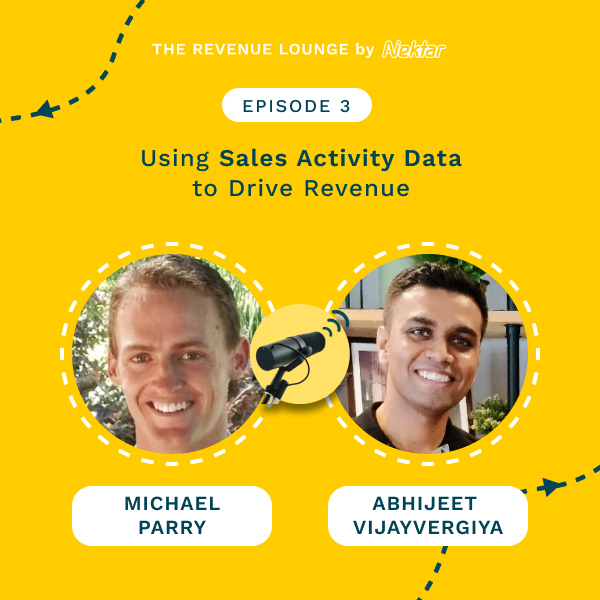
Ep #3: Using Activity Data to Drive Sales Productivity
Listen Now
Ep #4: Creating a Successful RevOps Roadmap
Listen Now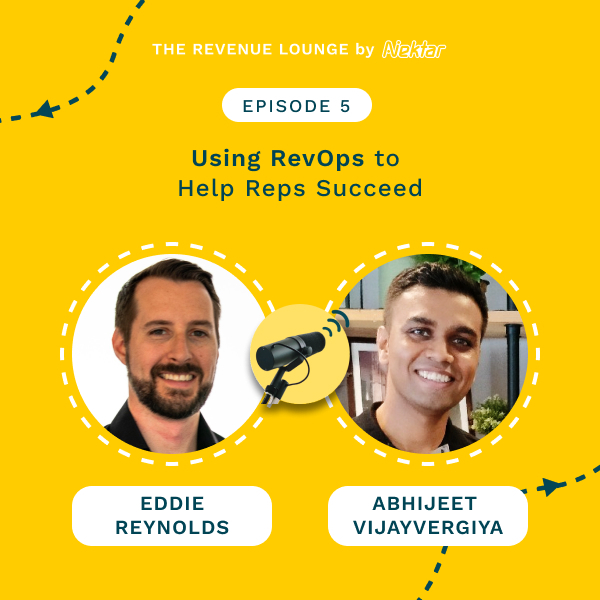
Ep #5: Using RevOps to Help Reps Succeed
Listen Now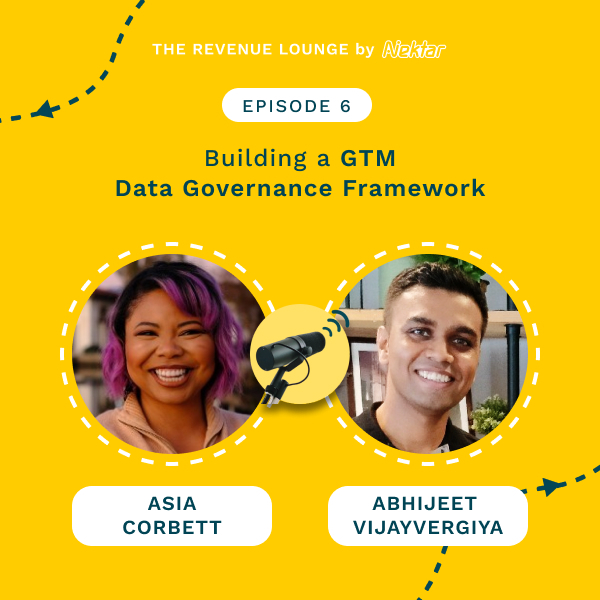
Ep #6: Building a GTM Data Governance Framework
Listen Now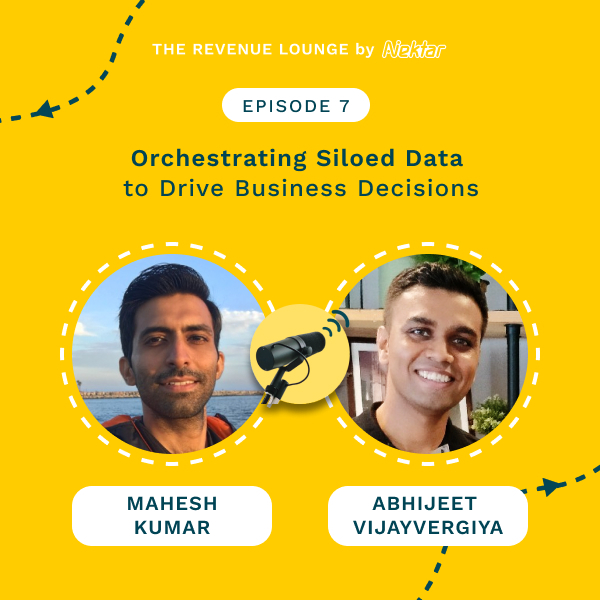
Ep #7: Orchestrating Siloed Data to Drive Business Decisions
Listen Now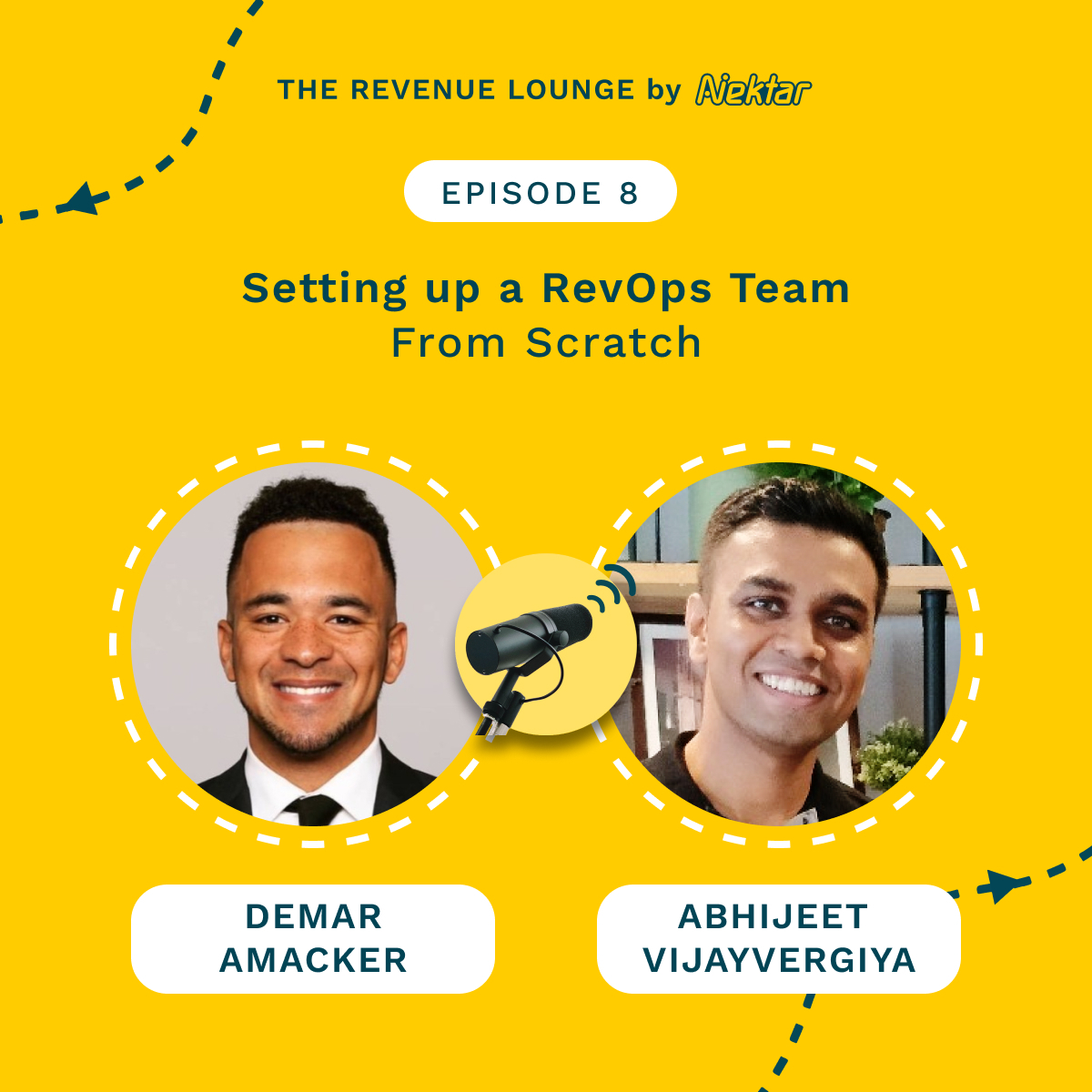
Ep #8: Setting Up a RevOps Team From Scratch
Listen Now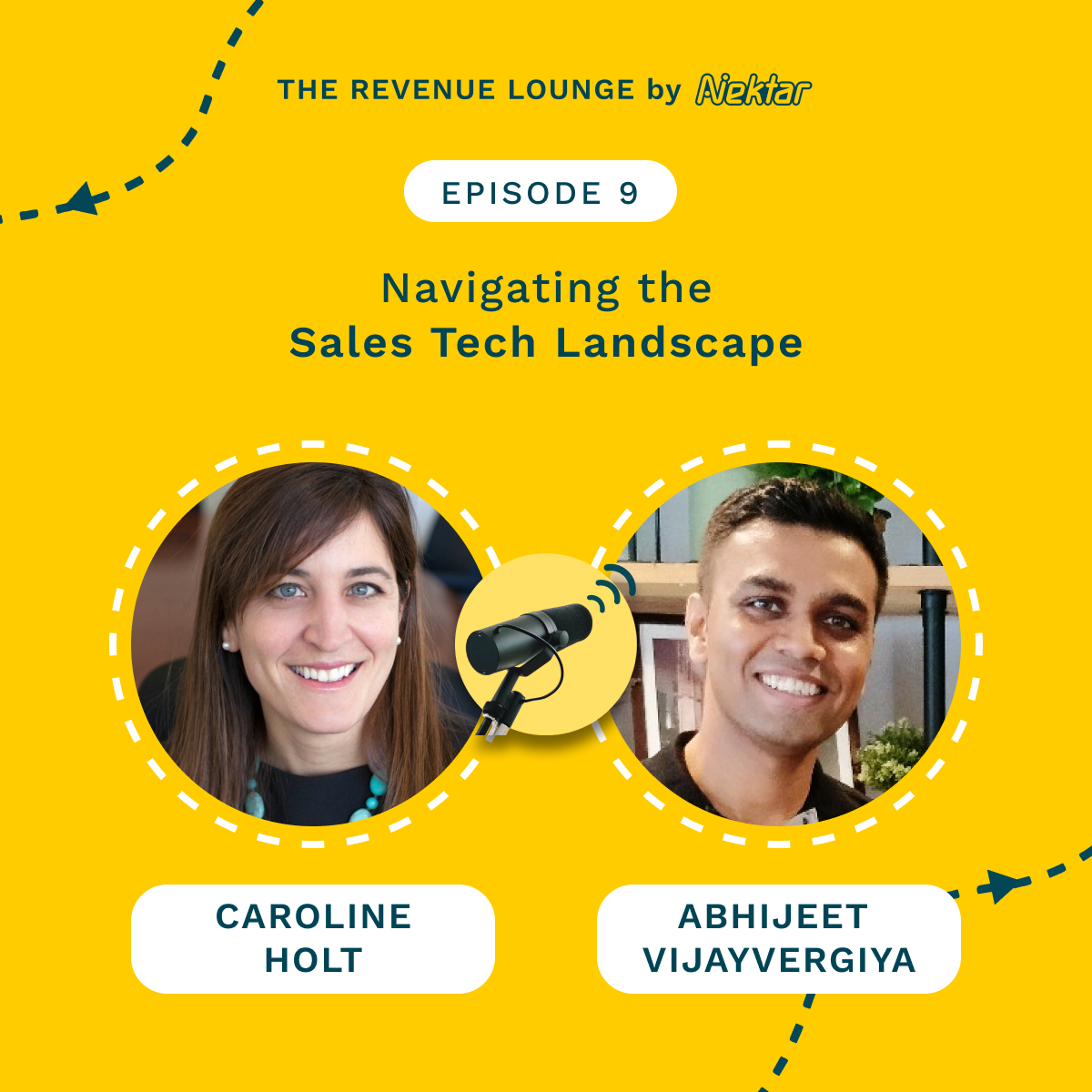
Ep #9: Navigating the Sales Tech Landscape
Listen Now